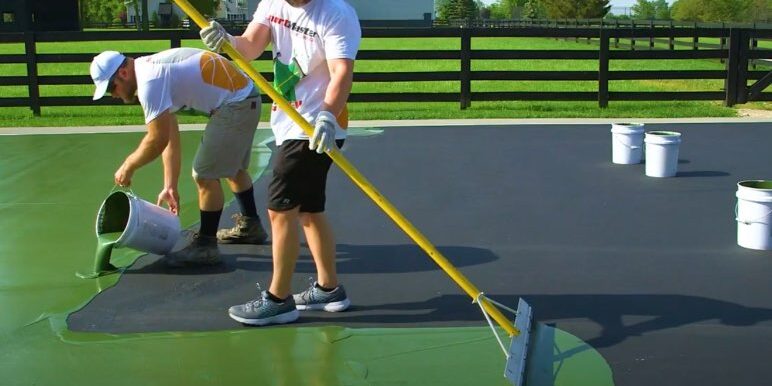Sustainable Practices in Pickleball Court Building You Must Know
As the appeal of pickleball proceeds to rise, so also does the requirement for sustainable techniques in court construction. The effect of these practices prolongs much beyond the court itself.
Selecting Eco-Friendly Products
Choosing eco-friendly materials is a critical step in the building of sustainable pickleball courts. The option of sustainable products not just reduces ecological influence yet also improves the long life and efficiency of the court. Key materials include reused rubber for the surface, which uses excellent longevity and shock absorption while diverting waste from land fills.
Additionally, using in your area sourced products lowers transportation emissions and supports regional economic climates. Pickleball court construction. As an example, utilizing indigenous woods for fence and seating can give a lasting visual while making certain resilience against the aspects.
Integrating absorptive materials for court structures can better contribute to sustainability by enabling all-natural water drainage and minimizing runoff. These options not just secure neighborhood ecological communities but likewise promote much healthier play environments.
Effective Water Drainage Solutions
While the choice of eco-friendly products is necessary, implementing effective water drainage solutions is similarly essential for keeping lasting pickleball courts. Proper drain not just protects the court surface area from water damages yet additionally minimizes erosion and runoff, promoting ecological integrity.
Effective drain systems can include permeable paving, which allows water to infiltrate the ground instead than pooling externally. This decreases the probability of standing water, which can result in mold and mildew and other upkeep issues. In addition, integrating purposefully positioned water drainage networks and swales can route excess water away from the court area, making certain a completely dry playing surface and avoiding soil disintegration.
Making use of indigenous plant life in the landscape design around the courts can better boost water drainage by taking in excess water and decreasing runoff. These plants call for much less irrigation and promote biodiversity, straightening with lasting methods.
Additionally, it is crucial to frequently maintain the drain system to ensure its lasting efficiency. This consists of clearing up debris and monitoring for clogs. By focusing on efficient drainage solutions, pickleball court builders can dramatically contribute to the sustainability and longevity of the center, ultimately benefiting both gamers and the environment.
Energy-Efficient Illumination Options
As the need for pickleball remains to grow, incorporating energy-efficient lighting choices right into court style has ended up being increasingly crucial for sustainability. Typical lighting systems typically take in too much power, adding to higher functional costs and environmental impact. As a result, taking on modern-day, energy-efficient modern technologies is important for both new constructions and remodellings.
LED (Light Emitting Diode) illumination sticks out as a leading option because of its longevity and power savings (Pickleball court construction). Contrasted to traditional lights, LEDs make use of about 75% much less power and can last approximately 25 times much longer, substantially lowering maintenance costs. Additionally, the directional nature of LED informative post lighting lessens light contamination, making sure that illumination is concentrated on the court as opposed to surrounding locations.

Lasting Surface Alternatives
Discovering sustainable surface options for pickleball courts has obtained traction among players and home builders alike. The focus on eco-friendly materials not just straightens with the growing environmental recognition but likewise boosts the efficiency and resilience of the courts.
This material provides superb shock absorption, lowering the danger of injuries for players while advertising sustainability. These ceramic tiles are simple to change and set up, and their adaptability enables for various court configurations.
All-natural grass courts are likewise becoming a lasting choice, advertising biodiversity and decreasing the warm island result. They call for normal upkeep and water, which might not align next with all sustainability goals.

Water Preservation Techniques

One my website more effective strategy includes the installation of rain harvesting systems. These systems accumulate and keep rain for usage in maintaining court surface areas and landscaping. This approach not just saves potable water yet additionally decreases reliance on metropolitan sources.
Moreover, utilizing drought-resistant landscaping around the courts is crucial. Native plants call for much less water and are better adjusted to local climate problems, therefore decreasing total water consumption. Furthermore, using efficient irrigation systems, such as drip watering, ensures that water is provided straight to plant roots, lessening dissipation and waste.
Conclusion
Integrating sustainable methods in pickleball court building substantially adds to environmental preservation and resource efficiency. Using environment-friendly materials, executing efficient drain options, and taking on energy-efficient lights alternatives can greatly reduce eco-friendly influence. Checking out sustainable surface area choices and utilizing water conservation strategies improve the overall sustainability of these entertainment facilities. By focusing on these methods, the building of pickleball courts can align with more comprehensive ecological objectives while promoting longevity and capability within neighborhoods.
As the appeal of pickleball continues to rise, so too does the demand for sustainable techniques in court building and construction.Choosing eco-friendly products is a vital action in the building of lasting pickleball courts. By prioritizing energy-efficient lights options, pickleball court erectors can contribute to a much more lasting future while fulfilling the needs of gamers and stakeholders alike.Incorporating sustainable surface area choices not only boosts the performance of pickleball courts however likewise paves the method for executing effective water preservation methods.Integrating lasting methods in pickleball court building and construction dramatically contributes to environmental preservation and source performance.